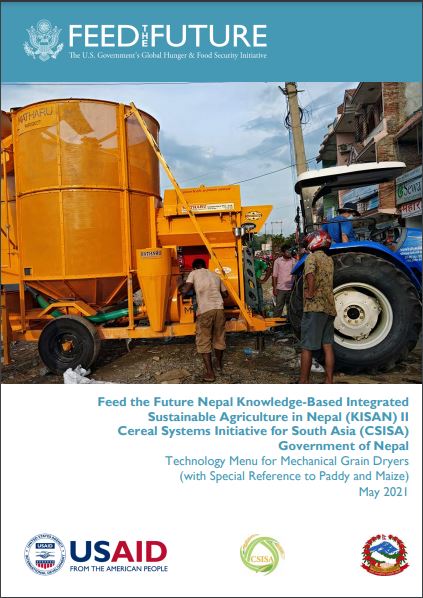Globally, one third of all food produced – 1.3 billion metric tons (MT) per year – goes to waste every year, an amount which could feed 37 million people for life2. In Nepal, post-harvest losses have been estimated to be 20-40% of the total agricultural production due to the lack of proper postharvest technologies3. Ensuring proper drying techniques is one of the most effective methods of eliminating the losses. Post-harvest management of grain is also one of the prime activities to fetch an attractive selling price. The traditional open sun drying method (drying on the stalk before cutting/harvesting, laying in the field after cutting/harvesting or threshing grain on a drying floor) is tedious, time-consuming and results in poor grain quality. Traditional drying systems are still practiced in many parts of the country because of their low cost and ease of management. To address this issue, high-performance mechanical dryers have been introduced in the country. Although initial costs are higher than sun drying, these are balanced by improvements to the grain and higher recovery rates. Mechanical drying systems include dryers which are used to reduce moisture in wet grain by forcing ambient or heated air through the grain bulk to achieve a required moisture level for storage. In these systems, the drying temperature can be controlled and drying takes place within few hours, resulting in high quality grain. Heat energy from burning biomass, furnace oil or electricity is utilized by mechanical dryers to dry a range of agricultural products. These systems have been successfully adopted by farmers and entrepreneurs throughout the world and are scientifically accepted. This document introduces and discusses different types of high-performance mechanical dryers (both fixed and portable), and makes recommendations for consideration by Government of Nepal, investors from the farming community, the private sector, Development Partners (DP) and NGO/INGOs. Rice is the principal food grain crop followed by maize and wheat in Nepal. Maize is the second most important staple food crop after rice. Winter crops (of which wheat is one) are harvested in the dry spring season and have low grain moisture. Spring rice (chaite dhan) is harvested at the beginning of the monsoon. It has a high moisture content, and the unpredictable weather at harvest time makes sun drying difficult, resulting in a large quantity of spring rice being lost every year. Summer maize is harvested at the end of monsoon and, like spring rice, its quality suffers greatly from high moisture content. Especially, in case of maize mycotoxin contamination is a big problem due to high moisture content which makes the food unsuitable not only for human consumption but also for animal feed. In order to explore innovative drying technologies suitable to Nepalese farmers, this technology menu has been developed adopting secondary information, literature review, field observations and focused group discussion with concerned stakeholders. This document discusses the range of grain-drying technologies which have been successfully adopted in Asia and worldwide, particularly in relation to post-harvest technologies/infrastructure associated with the drying of maize and paddy (particularly chaite dhan) suitable for Nepal. Of these, it lists the most commonly used types of dryer. This document presents the most important information about the dryer, including types, benefits, working principles, features, specifications, source of supply, estimated cost, custom duties, special requirements, and examples of institutions/organizations which have been using the dryers successfully. It is published to introduce to the reader the various drying systems able to address the issue of post-harvest loss, specifically in spring rice and maize. It sets out to familiarize the reader with the various dryers on the market, and to facilitate the most appropriate choice of dryer for every level of farmer and entrepreneur, according to their needs and the funds they have. This document is expected to help policymakers, extension workers, rice millers and feed industries, machinery suppliers, farmers and co-operatives in decision-making, as well as to reduce post-harvest losses, particular those incurred in drying.

